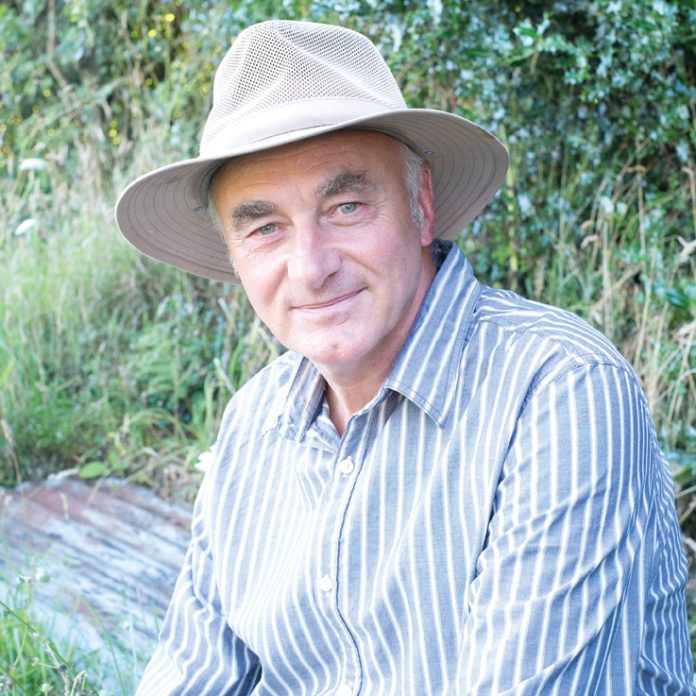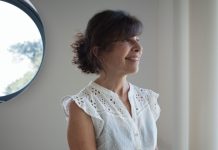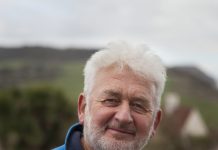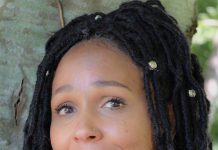‘I was born in Cheshire in 1955 and we moved to Corscombe in Dorset in 1960. I remember the really hard winter of 1962-1963 starting on boxing day right through to February. We were totally snowed in, we cut doorways through drifts and saw cars abandoned on the roads. People were ice skating on Sutton Bingham reservoir near Yeovil. My father worked in Yeovil as a Social Security Officer, mother was at home with me and my brother Paul who was 5 years older than me.
Then we moved to West Grange in West Hill, a fantastic old three-storey house with a cellar and an old staircase with a handrail I used to slide down. The cellar was always full of Dad’s homemade wine made from all sorts of free ingredients. We grew mushrooms down there too, using a bunk bed, planked out and filled with compost and sold them locally. My upbringing was fantastically unconventional. Although my father worked in an office, he was a country man at heart who loved to live off the land. A local character, Mr Brooks-King recognised my love of nature and took me and my mate, Terry Salter out birdwatching. He had a microphone in his hat and a portable tape recorder. We had to write down all the species of birds we saw. He could call a cuckoo over by imitating a female cuckoo noise, which is a very odd guttural burbling noise. Most of the time I hated school, I would much rather have been outside in the real world, wandering around the fields and woods. I got into growing vegetables from about eight years old; potatoes, strawberries and whatever else I could grow. Dad got some goats (Nancy and Susan) and chickens. I’d milk the goats and collect the eggs; I’d cut down branches to keep the goats busy eating whilst milking. Some of Dad’s customers had land and he kept geese or pigs or a couple of heifers there, which we would visit on Sundays. Mum and Dad split up when I was 17 and I went to live with my brother in Sidmouth.
My father had a heart attack when he was 58 and as a result, took early retirement and decided to buy a place with land. The only place he could find that he could afford was on Bodmin Moor. He started a piggery unit and got a contract for his baconers; he had a couple of cows and a few Dexter heifers. He didn’t live his dream for long, he died from another heart attack about 18 months later, in 1974, chasing pigs across the yard. I was only 19 and had to go down and look after the stock before it was sold at auction, I remember having to castrate the piglets with a razor blade! I was told his herd of pigs were some of the best they’d ever seen.
When I left school, I was into rough shooting; pigeons, rabbits etc and really wanted to be a gunsmith but the nearest place to get an apprenticeship was Bath and I wasn’t ready to leave home at that time.
During my time at Sidmouth Secondary I’d had the most inspirational metalwork teacher called Bernard Hughes, he was brilliant and basically treated me like a son. I managed to bunk off a lot of other lessons and would end up in the metalwork shop. He got me my first job at Brufords, a jeweller in Exeter where I started work as a silversmith. The workshop was an amazing four storey house behind the prison. They had a clockmaker; watchmaker, silversmith and a pearl stringer. Most of the work I did was repairing silver and what I really wanted was an apprenticeship making pieces. So, Mr Hughes managed to secure me a four-year art metal apprenticeship at Whipples in Exeter. I loved it but the money wasn’t great so when I’d completed the apprenticeship, I moved onto Devon instruments in Topsham where they made reproduction carriage clocks. They doubled my money and with that and taking in a lodger, meant I was able to buy my first house in Exeter for £13,500. But after four years I was made redundant when Devon Instruments went belly up. I then got a job with Bulmers cider as a Service Technician fitting cider pumps in pubs, hotels and nightclubs all over the South West.
I got married in 1981, to Linda, we had a son, Ashley, but sadly we divorced when he was two. After caring for Ashley every evening when Linda worked, I abruptly lost him from my life when I moved out. It was one of the worst times. I went to court to sort out access but the ruling, because of his age, was that I could only see him every two weeks on a Sunday morning for a few hours. I complied at the start but it was so painful for me and so upsetting and disruptive for a small child to cope with that I decided to stop with the hope that things would change when he was older. I just wanted the best for him. I have had to live with my choices that I thought were right at the time but really regret that we are still estranged. I hope that one day he will understand and that we can get to know each other.
I moved back to Sidmouth and met Diana; we were in similar situations. It developed into something wonderful and we married in 1989. We moved to Newton Poppleford where we had an allotment and I also got into alpine plants. We grew buckets of strawberries and flowers for drying; everyone ended up with dried flowers for Christmas. After eight years we moved to where we are now in Colyford, we have a bigger garden including a rockery and beds for the alpine plants. I never do anything by halves and joined every single plant society that I could – about 20! They do seed exchanges so I had the opportunity of getting some very rare seeds which enabled me to grow things I couldn’t have otherwise grown. I got into the species Erodium, which are related to the hardy Geranium. We used to go up every year to visit Diana’s mum in Yorkshire, and whilst they would go off to see the sites, I would search out interesting nurseries. One had the national collection of Erodiums; and at another we’d exchange plants. I let them have one of my new Erodium seedlings and as a reminder of where it came from, they added my name to the label. It was only recently, when I happened to google my name for something else, I found Erodium Peter Vernon. Amazingly it is RHS listed without any effort from me. A lady from America also showed up online as having it and I contacted her to ask how she managed to smuggle my plant back to America and she told me she put them in her knickers!
After 22 years working for Bulmers they got bought out and I was eventually made redundant. The redundancy and a supportive wife enabled me to think about what I was going to do next and I decided I didn’t want to work for anybody again. I set up on my own in 2004 as a full-time sculptor; an artist in wood where I developed my own way of doing things.
I got into the Blackdown Hills Business Association; they were brilliant. They had a pitch on Taunton High Street and that was one of my first experiences of selling direct to the public. I did a bit of woodturning to start with and made some jewellery boxes, then I started a bit of sculpting and had some great feedback. It was getting into sculpting and developing my own style that got me noticed. Around this time, I met James Luard, a retired captain in the Navy, he had a gallery on his farm in Stawley near Wellington. He got a little group of us together – potters, artists, painters, blacksmiths, people working with fabrics – the whole gambit. That’s where I met Frank Martin the potter, he was encouraging and said he like my work. He was on the board of the Somerset Guild of Craftsmen and I was invited to join and sell through their gallery and at various exhibitions. One day I got a phone call from the Guild’s manager saying someone had been in and bought one of my Manta Ray sculptures and was donating it to the Nature in Art Gallery and Museum in Twigworth, Gloucestershire. I contacted the curator who said I could come up and see my piece there. It was amazing, they’ve got pieces of Picasso and other top named artists, and there’s my sculpture in there. I’ve never done commission work as such; I make something and I put it in the gallery and if it sells that’s great. I concentrate mainly on nature with flowing forms. I’m virtually retired now, I do the odd bit and put a few pieces in galleries but not looking to sell myself anymore.
I have a number of hobbies and once I get into them, they take over my l life. I did moth traps every night of the year for two years, I’d record and photograph every one! I caught a moth that had never been found in Devon before. I met a lot of people through that. I wrote an article Magnificent Moths on moths and caterpillars for the East Devon Coast and Country Magazine.
I’d done some metal detecting back in the 80s when I got divorced as I’d needed a hobby to distract me. Then in about 2014 I met a local chap, Gordon, coming out of a field with a metal detector, got chatting and decided I wanted to get back into it again. The second time out I found a Bronze Age axe and since then I’ve found some wonderful things. I joined the EDMDC (East Devon Metal Detecting Club), they have a dig every fortnight. There are some great sites around here. Gordon and I discovered a Medieval fair site and have found many Medieval hammered silver coins on the site. I’ve worked my way up in EDMDC and made some great friends. I’m now a site officer, finding new sites, as well as photographer and also on the show committee. We usually have a presence at about three or four local agricultural shows a year, to let people know what we do and what we find and to hopefully encourage landowners to allow us to detect on their land. We usually have a table at our digs so the landowner can see what we’ve found. The club also has an annual charity dig.
It’s a peaceful spot where we live and enjoy our many different and varied hobbies; a lovely life.’










